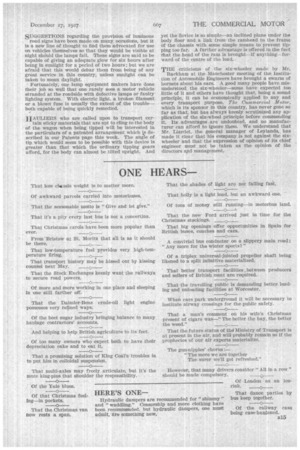SUGGESTIONS regarding the provision of luminous road signs have been
Page 29

If you've noticed an error in this article please click here to report it so we can fix it.
made on many occasions, but it is a new line of thought to find them advocated for use on vehicles themselves so that they would be visible at night shOuld the lamps fail. These signs are said to be capable of giving an adequate glow for six hours after being in sunlight for a period of two hours; but we are afraid • that this would debar them from being of any great service in this country, unless sunlight can be taken to mean daylight.
Fortunately, our lamp equipment makers have done their job so well that one rarely sees a motor vehicle stranded at the roadside with defective lamps or faulty lighting system. With electric light, a broken filament or a blown fuse is usually the extent of the trouble— both capable of being quickly remedied.
HAULIERS who are called upon to transport cer tain sticky materials that are apt to cling to the body of the wagon when being tipped will be interested in the particulars of a patented arrangement which is described in our Patents page this week. The angle of tip which would seem to be possible with this device is greater than that which the ordinary tipping gears afford, for the body can almost be tilted upright. And yet the Uevice is so simple—an inclined plane under the body floor and, a link from the ranihead to the frame of the chassis with some simple means to prevent tipping too far. A further advantage is offered in the fact that the head of the ram is brought—if anything—forward of the centre of the load.
THE criticisms of the six-wheeler made by Mr. Bockhorn at the Manchester meeting of the Institution of Automobile Engineers have brought a swarm of hornets about his ears. A good many people have misunderstood the six-wheeler—some have expected too little of it and others have thought that, being a sound principle, it can be economically applied to any and every transport purpose. The Commercial Motor, which is its sponsor in this country, has never gone so far as that, but has always keenly scrutinized any application of the six-wheel principle before commending it. Its advantages are undoubted, and no manufacturer can afford to ignore them. We understand that Mr. Liardet, the general manager of Leylands, has made it clear that his company is not against the sixwheeler and that the expression of opinion of its chief engineer must not be taken as the opinion of the directors and management.


























































































